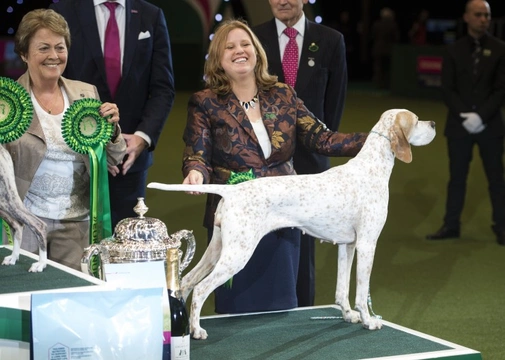
Introducing the Pointer - Reserve Best in Show at Crufts 2018
Every year, the dog breeds that take home the coveted Best in Show and Reserve Best in show awards at Crufts generate a lot of attention and interest, with many dog lovers wanting to find out more about them and perhaps, think about owning one themselves.
This year at Crufts, a whippet took first place – with a pointer coming in a close second. We’ll shine the spotlight on the whippet in another article – but in this article, we’re going to talk about the pointer dog breed, which saw one of its number taking home the Reserve Best in Show award at Crufts 2018.
The Reserve Best in Show winner at Crufts 2018 was Kanix Chilli, a pointer owned by Miss H Blackburn-Bennett. Kanix Chilli is an orange and white bitch who was aged eight years old when she finally took home the trophy, after a long and distinguished career of prior high-level Kennel Club show wins, culminating in her star turn on the Crufts podium.
If you fell for Chilli’s undeniable charms at Crufts and want to find out more about the pointer dog breed, or perhaps if you are thinking of buying a pointer of your own, we’ll share some useful information about the breed as a whole within this article. Read on to learn more.
What is a pointer?
A pointer is a medium to large-sized dog breed from the gundog grouping, which is also known in some circles as the English pointer rather than simply the pointer. They are one of the oldest recognised dog types with a known history going back hundreds of years, although they didn’t become hugely popular in the UK until the beginning of the 19th century.
During the 20th century, their prowess as gundogs became evident, and dogs of the pointer breed were already much in demand for use in gun sport. Their core skills include pointing, retrieving and honouring.
Pointing, from which the breed gets its name, means locating and “pointing out” game such as birds. When the dog identifies a potential target, they take up a still, standing stance and “point” their handlers in the direction of the bird by means of their posture and sharp concentration.
Retrieving means sniffing out downed game birds and bringing them back to their handlers – for which the pointer’s soft mouth is much prized, because it allows the dog to carry a fragile downed bird in their mouths without breaking the skin or damaging it.
Honouring refers to the dog’s ability and willingness to stop and point upon locating potential prey – rather than charging up to it and scaring it off or catching it!
However, whilst the pointer’s history consists mainly of working gundog roles, they also make for great pets and companions for experienced owners who understand the dogs’ core traits, and can provide them with an appropriate lifestyle, training and care.
Pointers can stand up to around 69cm tall at the withers and can weigh up to around 34kg, and they have short, single-layered coats and a very balanced, healthy conformation. They are graceful and distinctive looking and much admired, being popular with people from all walks of life.
Caring for a pointer
Pointers can and do thrive within domestic homes, but as a breed with a strong and active working history, they can be challenging to care for if you are not experienced with the breed and able to meet their needs.
Their high intelligence and high energy levels can make it challenging to keep the dog stimulated and occupied, and they need a lot of exercise and play every day to keep them happy and at their best. They won’t thrive within a sedentary lifestyle, and they are quite high maintenance in that they are very intolerant of being left alone.
However, they are very friendly and personable dogs that are generally excellent to train, being smart enough to learn and execute lots of commands and willing to try hard to please their handlers.
Their coats are short and don’t need a lot of brushing and grooming, and they aren’t particularly heavy shedders either.
Are pointers generally healthy?
The average lifespan for a pointer is 12-14 years, providing that they lead a healthy, active lifestyle and are fed a good quality and appropriate diet.
However, the breed as a whole does tend to have more than its fair share of hereditary health issues that plague the breed and can impact upon the health and longevity of individual dogs. The Kennel Club recommends that dogs of the breed be hip scored prior to breeding to ascertain their hip health, and also screened as part of the BVA/Kennel Club eye scheme.
Are pointers expensive to buy?
The pointer is way down the list of dog breeds in the UK ranked by popularity, coming in 92nd out of a total of 239 breeds. However, the fact that this year’s Reserve Best in Show at Crufts was a pointer may mean that the breed climbs up the rankings somewhat over the course of the coming year!
The average cost of a pedigree pointer is around £751, and for a non-pedigree, £558. However, there can of course be a lot of variance across the board – and dogs of the breed with a proven track record in the show ring, a known ancestry in good health, and with an impeccable pedigree may well cost a lot more!



